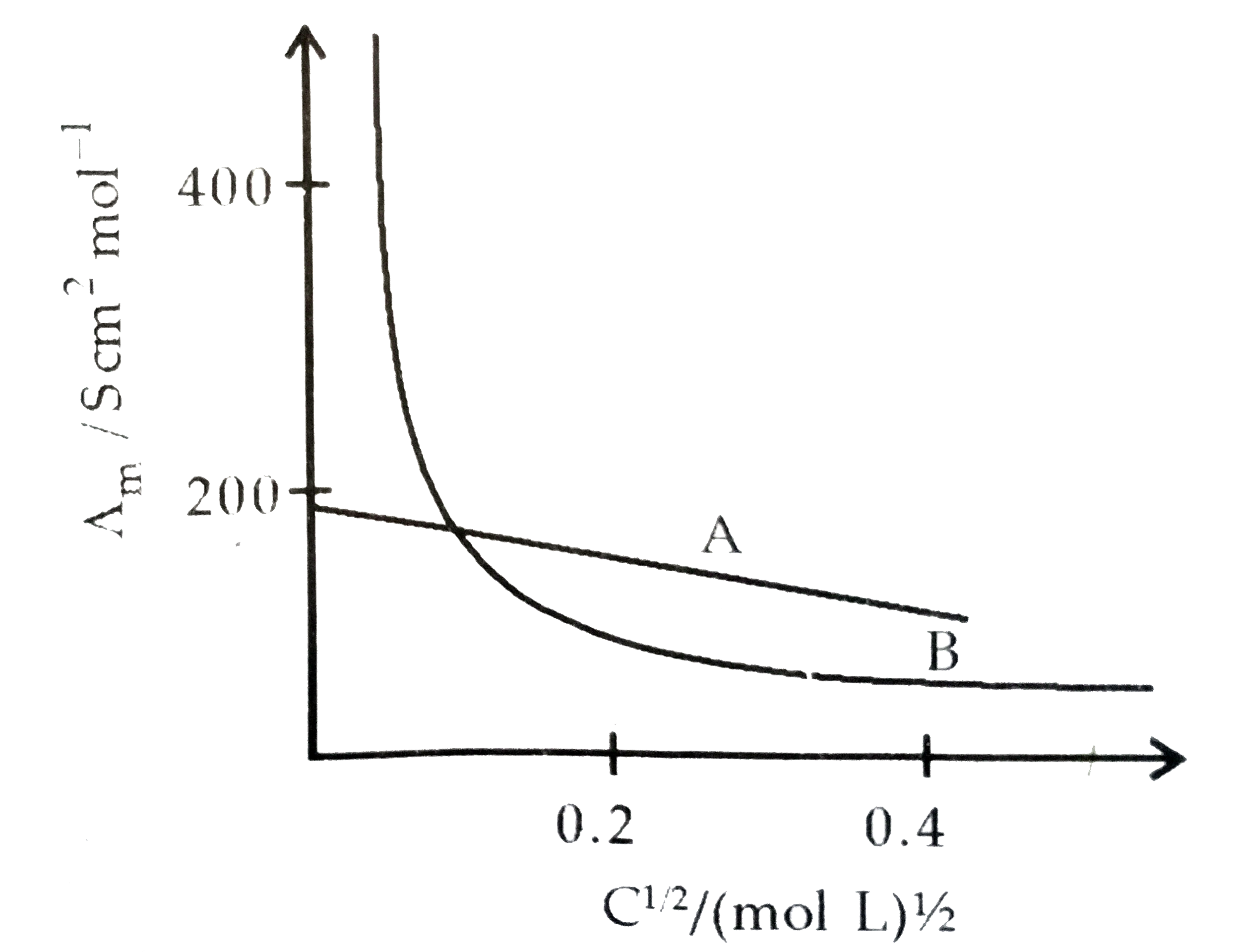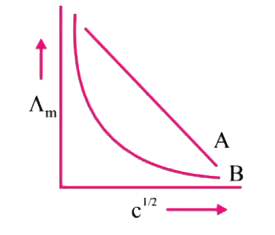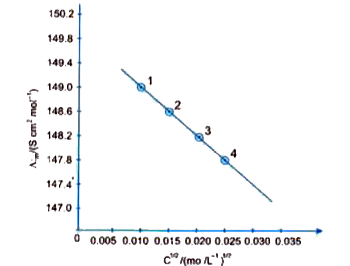The following curve is obtained when molar conductivity , Λm is plotted against the square root of concentration , C1/2 along y and x -axis respectively for the two electrolytes X and Y .

How can you determine Λ∞m for these electrolytes ?
For X,Λ∞m can be obtained by extrapolation to zero concentration .
For Y,Λ∞m can be calculated by using Kohlrausch law
Topper's Solved these Questions
- ELECTROCHEMISTRY BOOK - MODERN PUBLICATIONCHAPTER - ELECTROCHEMISTRY EXERCISE - COMPETITION FILE (OBJECTIVE TYPE QUESTIONS) (MULTIPLE CHOICE QUESTIONS )
35 Videos
- ELECTROCHEMISTRY BOOK - MODERN PUBLICATIONCHAPTER - ELECTROCHEMISTRY EXERCISE - COMPETITION FILE (OBJECTIVE TYPE QUESTIONS) B MULTIPLE CHOICE QUESTIONS
77 Videos
- ELECTROCHEMISTRY BOOK - MODERN PUBLICATIONCHAPTER - ELECTROCHEMISTRY EXERCISE - REVISION EXERCISES OBJECTIVE QUESTIONS Long Answer Questions
11 Videos
- D AND F-BLOCK ELEMENTSBOOK - MODERN PUBLICATIONCHAPTER - D AND F-BLOCK ELEMENTSEXERCISE - UNIT PRACTICE TEST
12 Videos
- GENERAL PRINCIPLES AND PROCESSES OF ISOLATION OF ELEMENTSBOOK - MODERN PUBLICATIONCHAPTER - GENERAL PRINCIPLES AND PROCESSES OF ISOLATION OF ELEMENTSEXERCISE - COMPETION FILE (Integer Type Numerical Value Type Questions)
5 Videos
Similar Questions
The following curve is obtained when molar conductivity Λm is plotted against the square root of concentration C1/2 (x-axis) for two electrolytes A and B :
(a) What can you say about the nature of the two electrolytes A and B ?
(b) How do you account for the increase in molar conductivity A, for the electrolytes A and B on dilution ?
View SolutionThe curves obtained when molar conductivity λm (along Y-axis) is plotted against the square root of concentration C1/2 (along X-axis) for two electrolytes 'A' and 'B' are shown.

(a) What can you say about the nature of the two electrolytes ?
(b) How do you account for the increase in molar conductivity Λm for the electrolytes A and B on dilution ?
View Solution
Knowledge Check
Statement: For a weak electrolyte, the plot of molar conductivity (Λm) against √C(C is concentration in mol litre−1) is nearly linear.
Explanation: The molar conductivity at infinite dilution (Λm) for an electrolyte can be considered equal to the sum of the limiting molar conductivities of the individual ions.AS is correct but E is wrong.BS is wrong but E is correc.CBoth S and E are correct and E is correct explanation of S.DBoth S and E are correct but E is correct explanation of S.
The following curve is obtained when molar conductivity (∧m) is plotted against the square root of concentration, c1/2 for two electrolytes A and B
(a) How do you account for the increase in the molar conductivity of the electrolyte A on dilution.

(b) As seen from the graph, the value of limiting molar conductivity (∧0m) for electrolyte B cannot be obtained graphically. How can this value be obtained?1
View SolutionThe following curve is obtained when molar conductivity (∧m) is plotted against the square root of concentration, c1/2 for two electrolytes A and B
(a) How do you account for the increase in the molar conductivity of the electrolyte A on dilution.

(b) As seen from the graph, the value of limiting molar conductivity (∧0m) for electrolyte B cannot be obtained graphically. How can this value be obtained?1
View Solution(a) A steady current of 2 amperes was passed through two electrolytic cells X and Y connected in series containing electrolytes FeSO4 and ZnSO4 until 2.8 g of Fe deposited at the cathode of cell X. How long did the current flow ? Calculate the mass of Zn deposited at the cathode of cell Y
(Molar mass : Fe= 56 g mol−1 Zn-65.3g mol−1, 1F -96500 C mol−1)
(b) In the plot of molar conductivity (∧m) vs Square root of concentration (c1/2), following curves are obtained for two electrolytes.
A and B:
Answer the following : (i) Predict the nature of electrolytes A and B. (ii) What happens on extrapolation of ∧m to concentration approaching zero for electrolytes A and B ?

View Solution(a) A steady current of 2 amperes was passed through two electrolytic cells X and Y connected in series containing electrolytes FeSO4 and ZnSO4 until 2.8 g of Fe deposited at the cathode of cell X. How long did the current flow ? Calculate the mass of Zn deposited at the cathode of cell Y
(Molar mass : Fe= 56 g mol−1 Zn-65.3g mol−1, 1F -96500 C mol−1)
(b) In the plot of molar conductivity (∧m) vs Square root of concentration (c1/2), following curves are obtained for two electrolytes.
A and B:
Answer the following : (i) Predict the nature of electrolytes A and B. (ii) What happens on extrapolation of ∧m to concentration approaching zero for electrolytes A and B ?

View SolutionIn the plot of molar conductivity (^ m) vs square root of concentration (c1/2) following curves are obtained for two electrolytes A and B :

Answer the following: (i) Predict the nature of electrolytes A and B.
(ii) What happens on extrapolation of ^ m to concentration approaching zero for electrolytes A and B?
View SolutionThe molar conductivity (Λm) of KCl solutions at different concentrations at 298 K is plotted as shown in the figure below:

Determine the value of Λ∘m and A for KCl.
View SolutionRead the given passage and answer the questions number that follow :
Molar conductivity increases with decrease in concentration. This is because the total volume, V, of solution containing one mole of electrolyte also increases. It has been found that decrease in K on dilution of a solution is more than compensated by increase in its volume. Physically, it means that at a given concentration, Am can be defined as the conductance of the electrolytic solution kept between the electrodes of a conductivity cell at unit distance but having area of cross-section large enough to accommodate sufficient volume of solution that contains one mole of the electrolyte. When concentration approaches zero, the molar conductivity is known as limiting molar conductivity and is represented by the symbol Λm The variation in Am with concentration is different for strong and weak electrolytes.
Is the variation in Λm with concentration same or different for weak and strong electrolytes ?
View Solution
